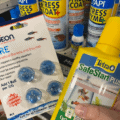When it comes to keeping your fish tank clean and maintaining a healthy environment for your underwater friends, regular cleaning is crucial. But how often should you clean a fish tank? The frequency of cleaning a fish tank can vary depending on various factors such as tank size, number of fish, filtration system, and water quality parameters. In this article, we will explore these factors and provide you with insights on determining the optimal cleaning frequency for your fish tank.

Understanding the Importance of Cleaning a Fish Tank
Cleaning your fish tank is essential for the well-being of your aquatic pets. A dirty tank can lead to poor water quality, which can negatively impact the health of your fish.
Regular cleaning helps remove harmful substances such as excess debris, uneaten food, and waste, preventing the accumulation of harmful chemicals like ammonia and nitrites. It also helps maintain proper oxygen levels in the water, ensuring a healthy environment for your fish to thrive.
Factors that Influence the Frequency of Cleaning a Fish Tank
Several factors influence how often you should clean your fish tank:
Tank Size and Water Volume
The size of your tank plays a significant role in determining the cleaning frequency. Larger tanks with a higher water volume tend to require less frequent cleaning compared to smaller ones. The larger volume of water helps dilute the waste produced by the fish, resulting in more stable water conditions.
Number and Size of Fish
The number and size of fish in your tank also impact the cleaning frequency. More fish in a tank means more waste production, consequently necessitating more regular cleaning. Additionally, larger fish tend to produce more waste, increasing the need for more frequent cleaning.
Type of Filtration System
The type and efficiency of your filtration system can affect the cleaning schedule. A high-quality filtration system can help remove impurities, toxins, and debris from the water, reducing the need for frequent cleaning. On the other hand, if your filtration system is not adequately functioning, you may need to clean the tank more often to maintain water quality.
Water Quality Parameters
Regular monitoring of water quality parameters such as pH, ammonia, nitrites, and nitrates is essential for determining the cleaning frequency. If these parameters are consistently outside the recommended range, it may indicate the need for more frequent cleaning.

Signs that Indicate Your Fish Tank Needs Cleaning
Knowing when to clean your fish tank is crucial to maintaining a healthy environment for your fish. Here are some signs that indicate your fish tank needs cleaning:
Cloudy or Discolored Water
If your tank water appears cloudy or has an unusual discoloration, it could be an indication of high levels of particles, debris, or bacteria. This typically occurs when the tank has not been cleaned for an extended period.
Algae Growth
Excessive algae growth is a common problem in fish tanks. If you notice a greenish tint on the glass or decorations, it is a sign that algae have proliferated. Regular cleaning and maintenance can help prevent excessive algae growth.
Excessive Debris or Waste
If you observe a buildup of uneaten food, waste, or debris on the tank’s substrate or decorations, it is an indication that cleaning is necessary. Besides affecting water quality, decaying organic matter can produce toxic substances harmful to your fish.
Unhealthy Fish Behavior or Appearance
Any changes in your fish’s behavior or appearance, such as lethargy, loss of appetite, or unusual markings, can be an indicator of poor water quality. Cleaning the tank and improving water conditions can help alleviate these issues.

Determining the Optimal Cleaning Frequency for Your Fish Tank
While there are general guidelines for cleaning frequency based on popular aquarium setups, determining the optimal cleaning frequency for your specific fish tank involves considering the factors mentioned above.
Especially if you have acrylic tanks that require special care. The answer to “How often should I clean” depends on so many factors. Start with the recommended guidelines, and then adjust based on your tank’s conditions.
To maintain a clean and healthy fish tank, follow these tips:
Regularly Performing Partial Water Changes
Regular partial water changes, typically around 10-15% of the total water volume, help remove accumulated waste and replenish essential minerals.
Aim to perform water changes every two weeks as a starting point, adjusting as needed based on the condition of your tank. The frequency with which you should change the water depends on factors like the size of the tank, how many fish you have, and the presence of dead fish.
Always treat tap water with a water conditioner to remove chlorine and chloramine before adding it to the tank. Ensure the fresh water is the same temperature as the tank water before putting fish back into the aquarium.
Proper Feeding Habits and Waste Management
Avoid overfeeding your fish, as excess food can result in increased waste production. Consistently monitor feeding habits and remove any uneaten food after a few minutes. This helps minimize the amount of waste accumulating in the tank.
Routine Maintenance of the Filtration System
Regularly check and clean the filter to ensure it is functioning correctly. Follow the manufacturer’s instructions for maintenance to prevent clogging and maintain optimal filtration efficiency.
Monitoring Water Quality Parameters
Regularly test water parameters such as pH, ammonia, nitrites, and nitrates. This will help you determine if your tank requires cleaning or if adjustments to the cleaning frequency are necessary.
Maintaining Aquarium Biological Filtration
The biological filtration in your freshwater fish tank relies on beneficial bacteria to break down harmful fish waste into less toxic substances. This natural cleaning process helps maintain water quality and creates a healthier environment for your fish.
Cleaning Aquarium Decorations
Regularly cleaning decorations, especially those made of acrylic, in your freshwater fish tank is important. Removing algae and debris prevents buildup and maintains the aesthetic appeal of your aquarium.
Vacuuming the Aquarium Gravel
Using a gravel vacuum is an effective way to remove fish waste and uneaten food from the substrate of your freshwater fish tank. This cleaning process helps to maintain water quality and reduce the buildup of harmful substances that could affect your fish’s health.

Common Mistakes to Avoid When Cleaning a Fish Tank
While cleaning your fish tank is essential, it’s important to avoid common mistakes that can harm your fish and disrupt the tank’s ecosystem:
Overcleaning or Disturbing the Beneficial Bacteria
Avoid overcleaning your tank, as it can remove beneficial bacteria that help maintain a balanced ecosystem. These bacteria are responsible for breaking down harmful substances in the water. Only clean what is necessary and avoid excessive disturbance to the substrate and decorations.
Using Improper Cleaning Agents or Tools
When cleaning your fish tank, use designated aquarium-safe cleaning agents and tools to avoid introducing unwanted chemicals into the water. Regular household cleaning agents can be toxic to fish and disrupt the tank’s delicate balance.
Neglecting to Regularly Maintain the Filtration System
Avoid neglecting the maintenance of your filtration system. A clogged or inefficient filter can compromise water quality and increase the need for more frequent cleaning. Clean or replace filter media as recommended by the manufacturer.
Frequently Asked Questions about Fish Tank Cleaning
Can I clean my fish tank too often?
While regular cleaning is essential, cleaning your fish tank too often can disrupt the tank’s balance and impact the growth of beneficial bacteria. Follow the recommended cleaning guidelines and adjust as needed based on the condition of your tank.
Can I clean my fish tank without removing the fish?
Yes, it is possible to clean your fish tank without removing the fish. By using a siphon to remove debris and waste while performing a partial water change, you can maintain a clean environment for your fish while minimizing stress.
Do I need to remove all the decorations for cleaning?
You don’t need to remove all the decorations for every cleaning. However, it’s advisable to rotate and clean them periodically to remove any accumulated debris or algae. This helps maintain the aesthetics of the tank and prevents the buildup of harmful substances.
How can I prevent algae growth in my fish tank?
To prevent excessive algae growth, maintain a regular cleaning schedule, control lighting duration, avoid overfeeding, and consider using algae-eating fish or other natural methods to keep algae in check. Additionally, keeping your tank away from direct sunlight can help reduce algae growth.

Tips for Maintaining a Clean and Healthy Fish Tank
In addition to regular cleaning, here are some tips for maintaining a clean and healthy fish tank:
- Observe and monitor your fish regularly for any signs of illness or stress.
- Avoid introducing new fish without quarantining them first to prevent the spread of diseases.
- Regularly remove dead plants or uneaten food from the tank.
- Ensure proper water circulation and oxygenation by positioning the filter and airstone correctly.
- Perform regular water tests to ensure optimal water quality.
- Consider adding live plants to the tank, as they can help absorb excess nutrients and improve water quality.

Conclusion
Regular cleaning is essential for maintaining a clean, healthy, and visually appealing fish tank. The frequency of cleaning depends on factors such as tank size, number of fish, filtration system, and water quality parameters.
By understanding these factors and following the recommended guidelines, you can provide the best environment for your fish to thrive. Remember to monitor water quality regularly, adjust cleaning frequency as needed, and avoid common mistakes to ensure the well-being of your aquatic pets.











1 thought on “How Often Should You Clean A Fish Tank?”